The Role of AI, Chatbots and Shopping Assistants in Mobile E-Commerce
VerifiedAdded on 2023/04/21
|9
|1310
|85
Case Study
AI Summary
This case study examines the growing popularity of on-demand mobile e-commerce and the integration of technologies like AI, chatbots, and shopping assistants. It highlights how e-commerce platforms are leveraging these tools to enhance customer service, personalize shopping experiences, and drive sales. The study discusses the increasing use of chatbots for customer interaction, providing product recommendations, and facilitating communication. It also touches upon the analysis of consumer data to predict preferences and improve the overall e-commerce experience through mobile computing. The case study concludes that AI and shopping assistants significantly improve mobile e-commerce by making the shopping experience better for consumers and allowing for better data collection.

Running head: ON DEMAND MOBILE E-COMMERCE
ON DEMAND MOBILE E-COMMERCE
Name of the Student:
Name of the University:
Author Note:
ON DEMAND MOBILE E-COMMERCE
Name of the Student:
Name of the University:
Author Note:
Paraphrase This Document
Need a fresh take? Get an instant paraphrase of this document with our AI Paraphraser
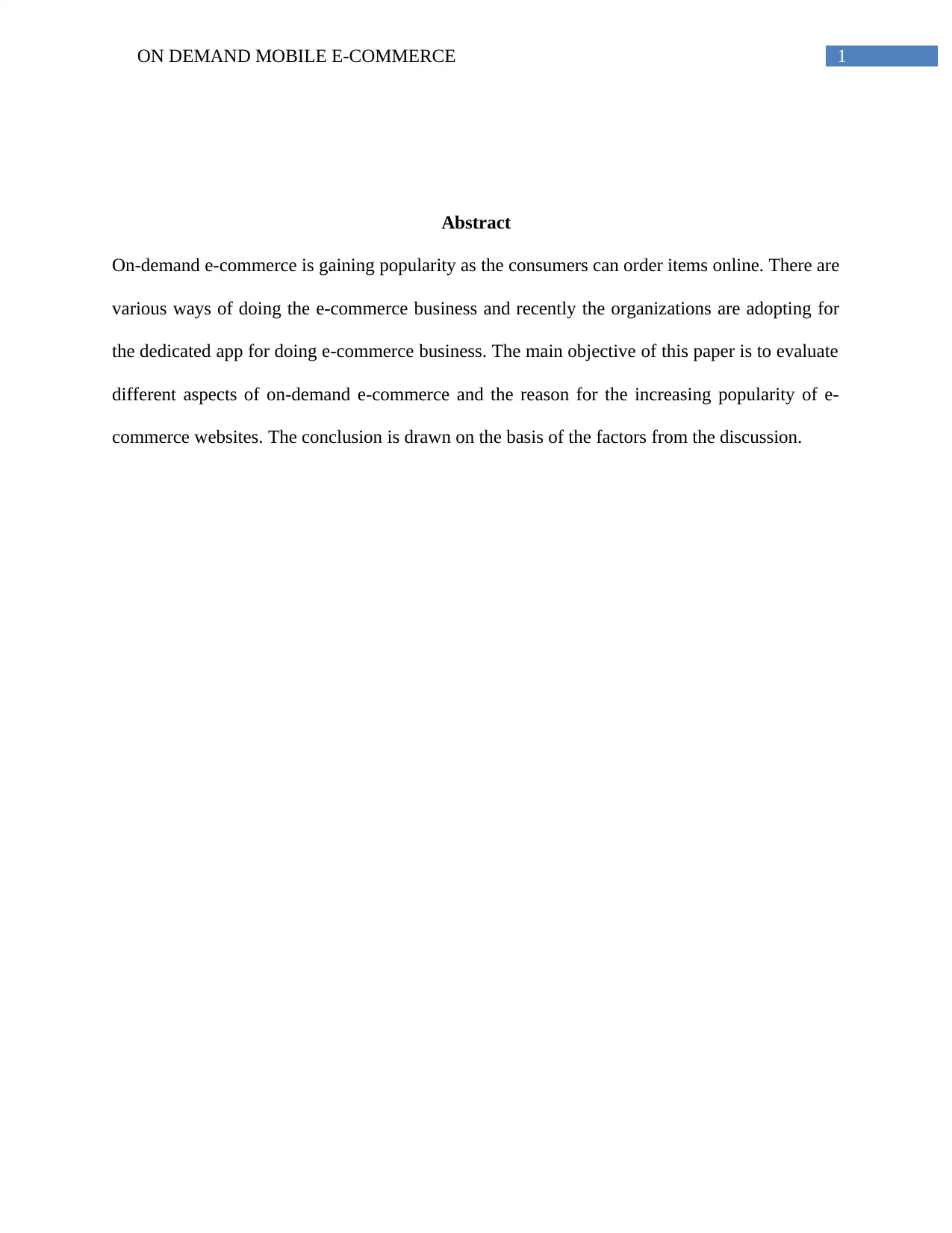
1ON DEMAND MOBILE E-COMMERCE
Abstract
On-demand e-commerce is gaining popularity as the consumers can order items online. There are
various ways of doing the e-commerce business and recently the organizations are adopting for
the dedicated app for doing e-commerce business. The main objective of this paper is to evaluate
different aspects of on-demand e-commerce and the reason for the increasing popularity of e-
commerce websites. The conclusion is drawn on the basis of the factors from the discussion.
Abstract
On-demand e-commerce is gaining popularity as the consumers can order items online. There are
various ways of doing the e-commerce business and recently the organizations are adopting for
the dedicated app for doing e-commerce business. The main objective of this paper is to evaluate
different aspects of on-demand e-commerce and the reason for the increasing popularity of e-
commerce websites. The conclusion is drawn on the basis of the factors from the discussion.
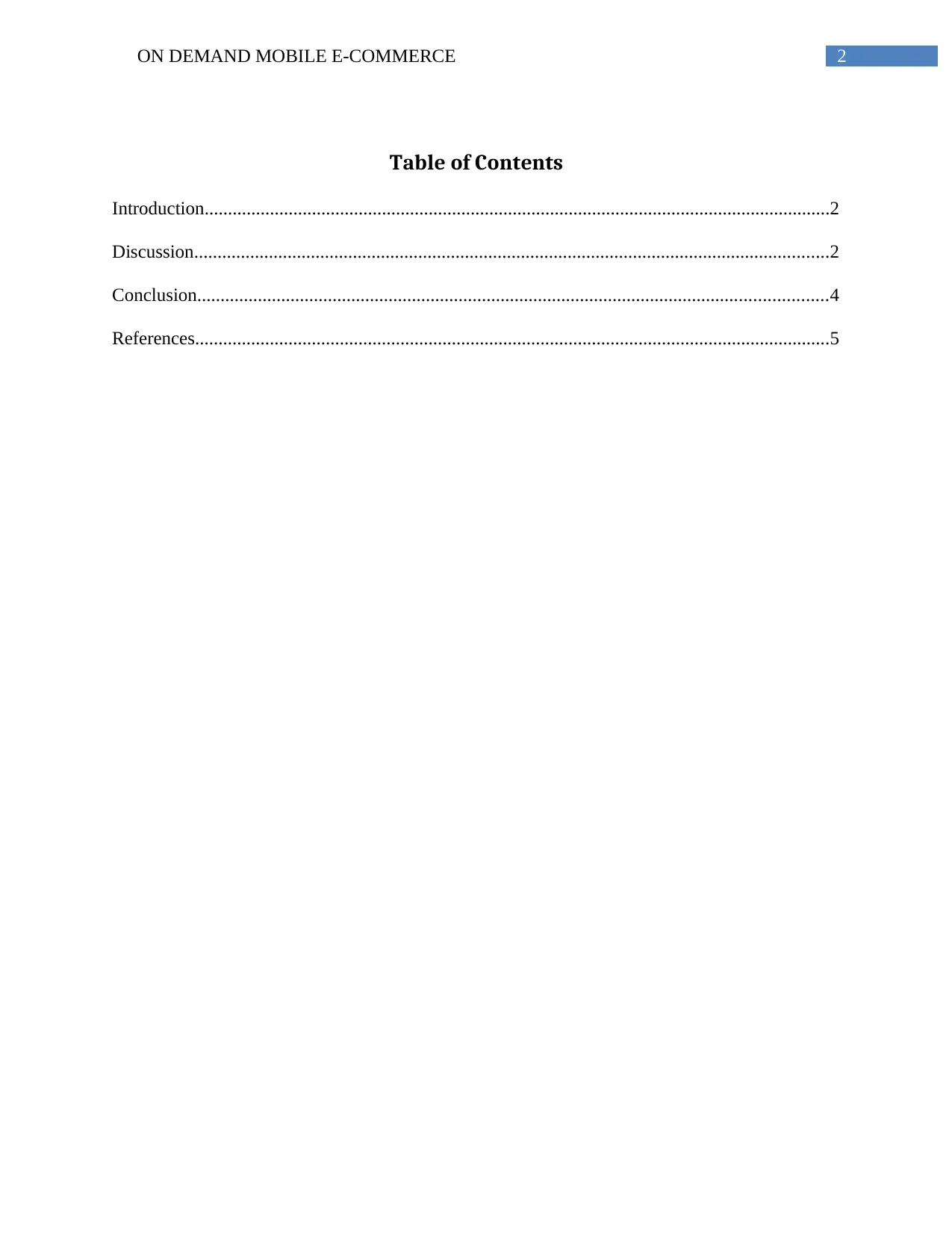
2ON DEMAND MOBILE E-COMMERCE
Table of Contents
Introduction......................................................................................................................................2
Discussion........................................................................................................................................2
Conclusion.......................................................................................................................................4
References........................................................................................................................................5
Table of Contents
Introduction......................................................................................................................................2
Discussion........................................................................................................................................2
Conclusion.......................................................................................................................................4
References........................................................................................................................................5
⊘ This is a preview!⊘
Do you want full access?
Subscribe today to unlock all pages.

Trusted by 1+ million students worldwide
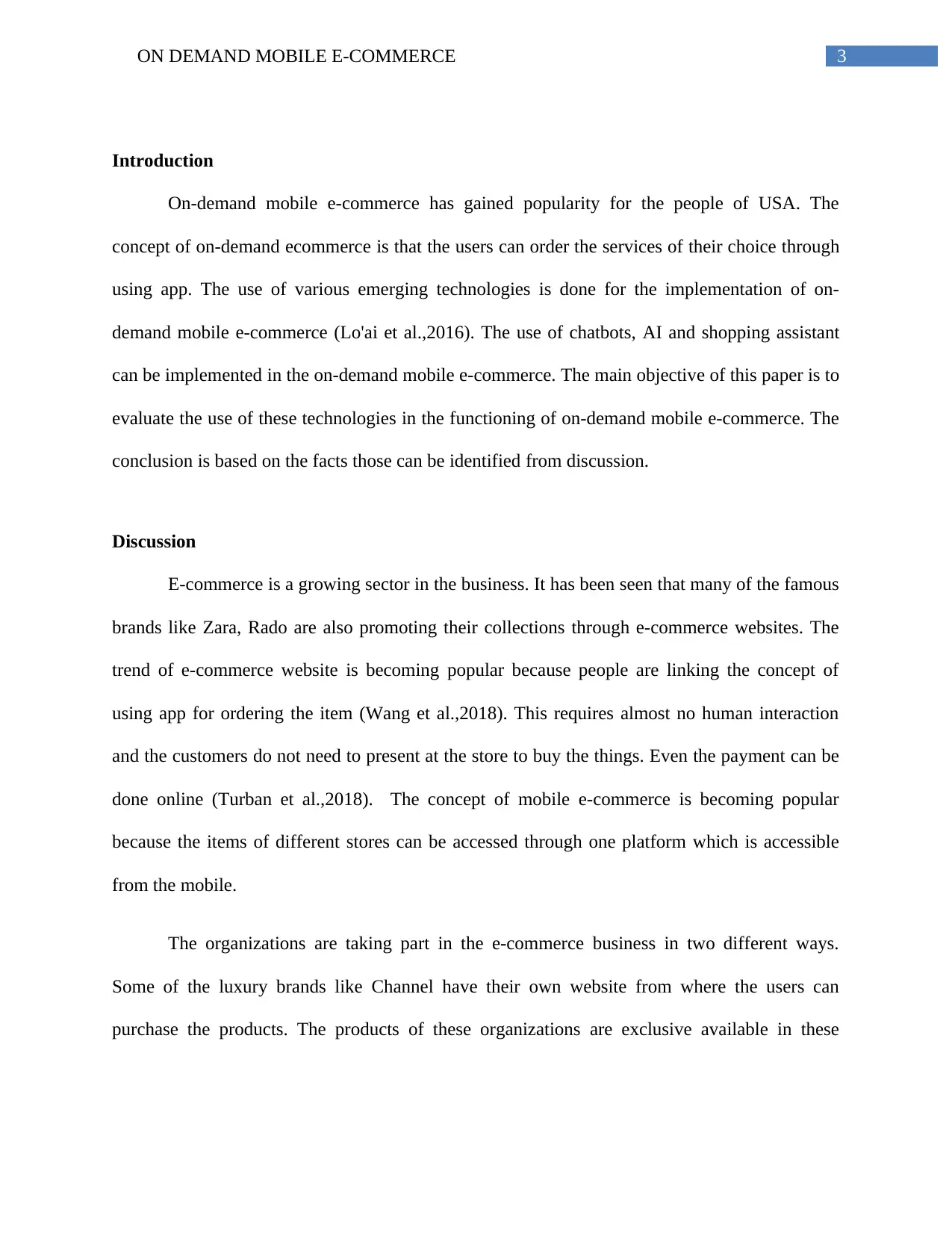
3ON DEMAND MOBILE E-COMMERCE
Introduction
On-demand mobile e-commerce has gained popularity for the people of USA. The
concept of on-demand ecommerce is that the users can order the services of their choice through
using app. The use of various emerging technologies is done for the implementation of on-
demand mobile e-commerce (Lo'ai et al.,2016). The use of chatbots, AI and shopping assistant
can be implemented in the on-demand mobile e-commerce. The main objective of this paper is to
evaluate the use of these technologies in the functioning of on-demand mobile e-commerce. The
conclusion is based on the facts those can be identified from discussion.
Discussion
E-commerce is a growing sector in the business. It has been seen that many of the famous
brands like Zara, Rado are also promoting their collections through e-commerce websites. The
trend of e-commerce website is becoming popular because people are linking the concept of
using app for ordering the item (Wang et al.,2018). This requires almost no human interaction
and the customers do not need to present at the store to buy the things. Even the payment can be
done online (Turban et al.,2018). The concept of mobile e-commerce is becoming popular
because the items of different stores can be accessed through one platform which is accessible
from the mobile.
The organizations are taking part in the e-commerce business in two different ways.
Some of the luxury brands like Channel have their own website from where the users can
purchase the products. The products of these organizations are exclusive available in these
Introduction
On-demand mobile e-commerce has gained popularity for the people of USA. The
concept of on-demand ecommerce is that the users can order the services of their choice through
using app. The use of various emerging technologies is done for the implementation of on-
demand mobile e-commerce (Lo'ai et al.,2016). The use of chatbots, AI and shopping assistant
can be implemented in the on-demand mobile e-commerce. The main objective of this paper is to
evaluate the use of these technologies in the functioning of on-demand mobile e-commerce. The
conclusion is based on the facts those can be identified from discussion.
Discussion
E-commerce is a growing sector in the business. It has been seen that many of the famous
brands like Zara, Rado are also promoting their collections through e-commerce websites. The
trend of e-commerce website is becoming popular because people are linking the concept of
using app for ordering the item (Wang et al.,2018). This requires almost no human interaction
and the customers do not need to present at the store to buy the things. Even the payment can be
done online (Turban et al.,2018). The concept of mobile e-commerce is becoming popular
because the items of different stores can be accessed through one platform which is accessible
from the mobile.
The organizations are taking part in the e-commerce business in two different ways.
Some of the luxury brands like Channel have their own website from where the users can
purchase the products. The products of these organizations are exclusive available in these
Paraphrase This Document
Need a fresh take? Get an instant paraphrase of this document with our AI Paraphraser
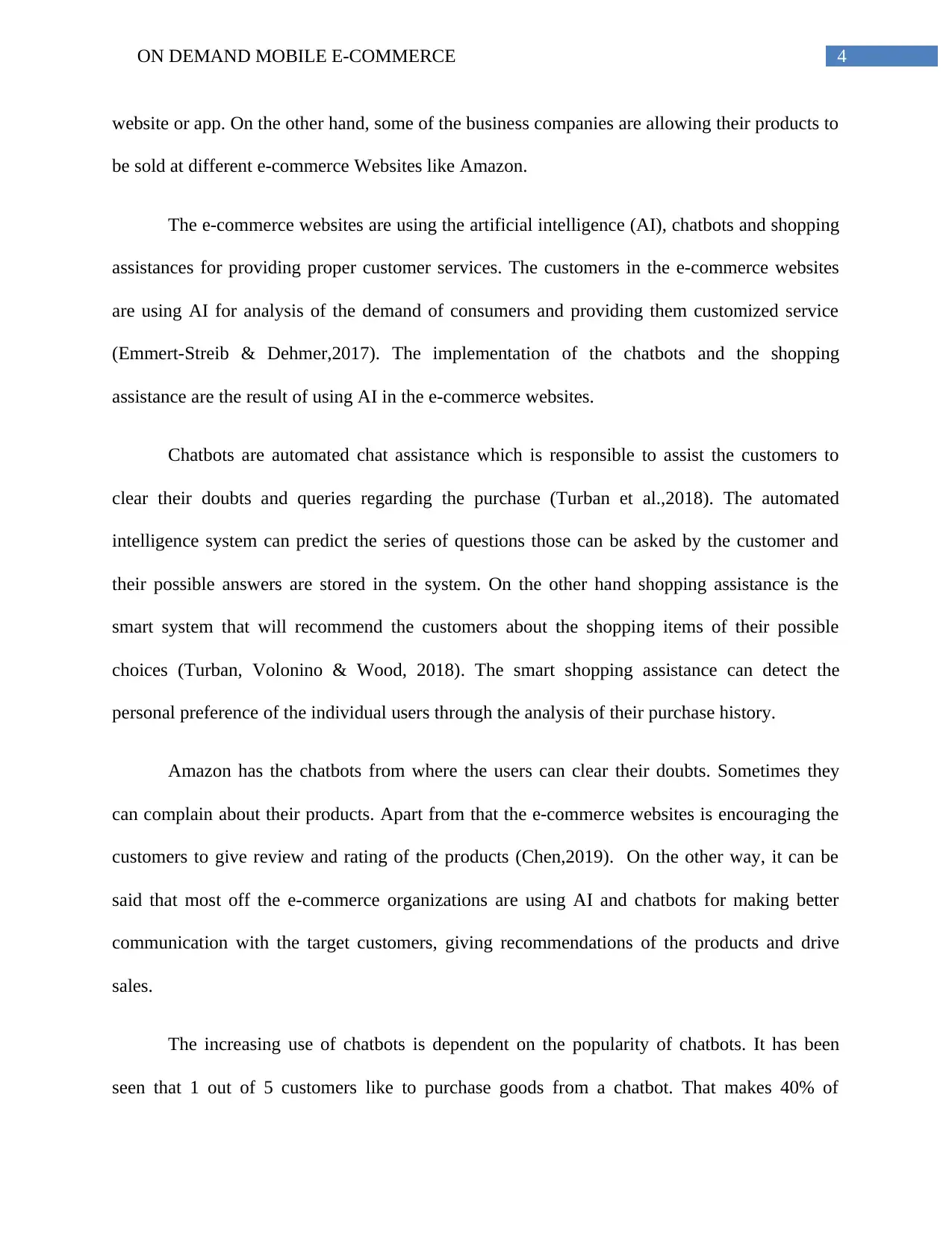
4ON DEMAND MOBILE E-COMMERCE
website or app. On the other hand, some of the business companies are allowing their products to
be sold at different e-commerce Websites like Amazon.
The e-commerce websites are using the artificial intelligence (AI), chatbots and shopping
assistances for providing proper customer services. The customers in the e-commerce websites
are using AI for analysis of the demand of consumers and providing them customized service
(Emmert-Streib & Dehmer,2017). The implementation of the chatbots and the shopping
assistance are the result of using AI in the e-commerce websites.
Chatbots are automated chat assistance which is responsible to assist the customers to
clear their doubts and queries regarding the purchase (Turban et al.,2018). The automated
intelligence system can predict the series of questions those can be asked by the customer and
their possible answers are stored in the system. On the other hand shopping assistance is the
smart system that will recommend the customers about the shopping items of their possible
choices (Turban, Volonino & Wood, 2018). The smart shopping assistance can detect the
personal preference of the individual users through the analysis of their purchase history.
Amazon has the chatbots from where the users can clear their doubts. Sometimes they
can complain about their products. Apart from that the e-commerce websites is encouraging the
customers to give review and rating of the products (Chen,2019). On the other way, it can be
said that most off the e-commerce organizations are using AI and chatbots for making better
communication with the target customers, giving recommendations of the products and drive
sales.
The increasing use of chatbots is dependent on the popularity of chatbots. It has been
seen that 1 out of 5 customers like to purchase goods from a chatbot. That makes 40% of
website or app. On the other hand, some of the business companies are allowing their products to
be sold at different e-commerce Websites like Amazon.
The e-commerce websites are using the artificial intelligence (AI), chatbots and shopping
assistances for providing proper customer services. The customers in the e-commerce websites
are using AI for analysis of the demand of consumers and providing them customized service
(Emmert-Streib & Dehmer,2017). The implementation of the chatbots and the shopping
assistance are the result of using AI in the e-commerce websites.
Chatbots are automated chat assistance which is responsible to assist the customers to
clear their doubts and queries regarding the purchase (Turban et al.,2018). The automated
intelligence system can predict the series of questions those can be asked by the customer and
their possible answers are stored in the system. On the other hand shopping assistance is the
smart system that will recommend the customers about the shopping items of their possible
choices (Turban, Volonino & Wood, 2018). The smart shopping assistance can detect the
personal preference of the individual users through the analysis of their purchase history.
Amazon has the chatbots from where the users can clear their doubts. Sometimes they
can complain about their products. Apart from that the e-commerce websites is encouraging the
customers to give review and rating of the products (Chen,2019). On the other way, it can be
said that most off the e-commerce organizations are using AI and chatbots for making better
communication with the target customers, giving recommendations of the products and drive
sales.
The increasing use of chatbots is dependent on the popularity of chatbots. It has been
seen that 1 out of 5 customers like to purchase goods from a chatbot. That makes 40% of
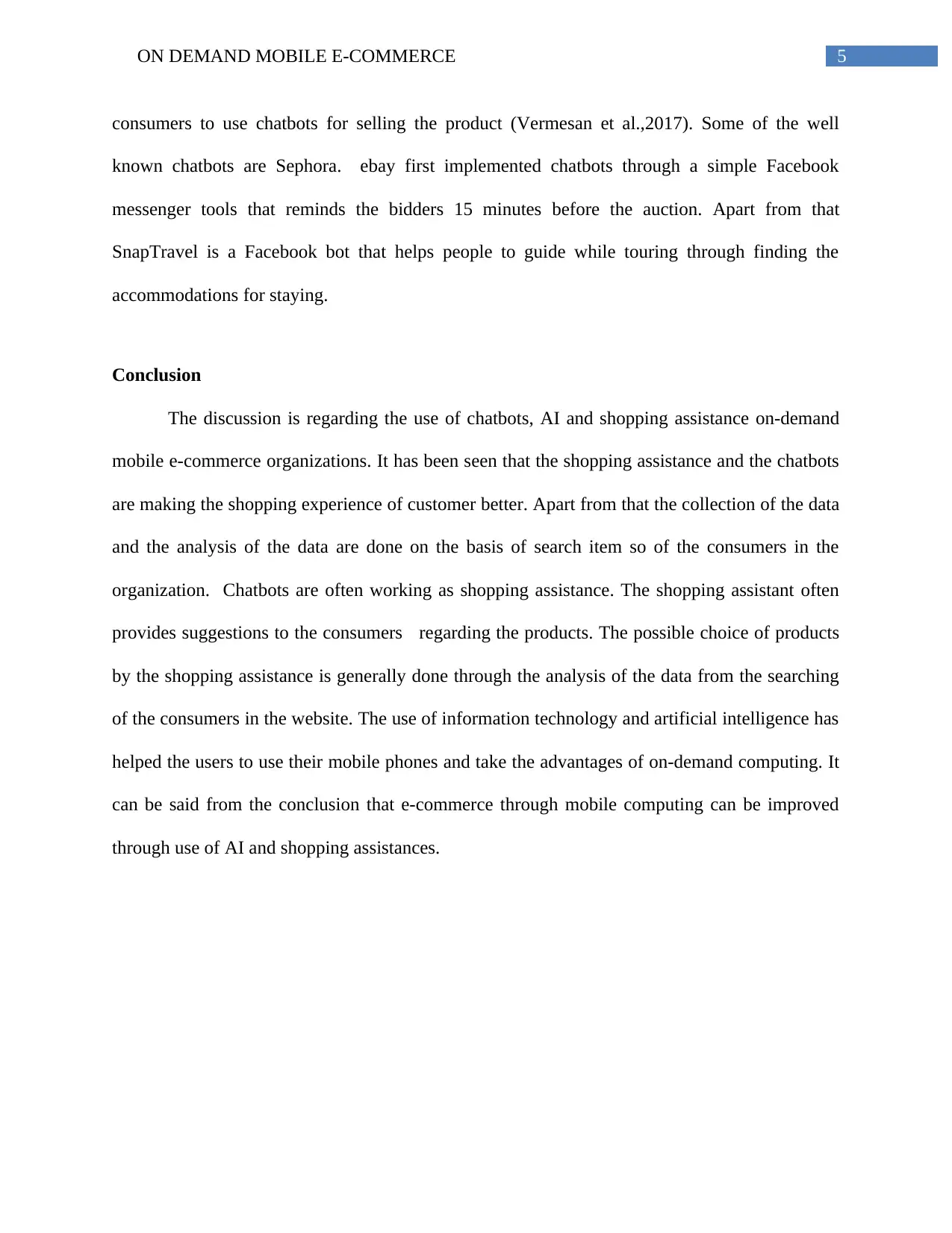
5ON DEMAND MOBILE E-COMMERCE
consumers to use chatbots for selling the product (Vermesan et al.,2017). Some of the well
known chatbots are Sephora. ebay first implemented chatbots through a simple Facebook
messenger tools that reminds the bidders 15 minutes before the auction. Apart from that
SnapTravel is a Facebook bot that helps people to guide while touring through finding the
accommodations for staying.
Conclusion
The discussion is regarding the use of chatbots, AI and shopping assistance on-demand
mobile e-commerce organizations. It has been seen that the shopping assistance and the chatbots
are making the shopping experience of customer better. Apart from that the collection of the data
and the analysis of the data are done on the basis of search item so of the consumers in the
organization. Chatbots are often working as shopping assistance. The shopping assistant often
provides suggestions to the consumers regarding the products. The possible choice of products
by the shopping assistance is generally done through the analysis of the data from the searching
of the consumers in the website. The use of information technology and artificial intelligence has
helped the users to use their mobile phones and take the advantages of on-demand computing. It
can be said from the conclusion that e-commerce through mobile computing can be improved
through use of AI and shopping assistances.
consumers to use chatbots for selling the product (Vermesan et al.,2017). Some of the well
known chatbots are Sephora. ebay first implemented chatbots through a simple Facebook
messenger tools that reminds the bidders 15 minutes before the auction. Apart from that
SnapTravel is a Facebook bot that helps people to guide while touring through finding the
accommodations for staying.
Conclusion
The discussion is regarding the use of chatbots, AI and shopping assistance on-demand
mobile e-commerce organizations. It has been seen that the shopping assistance and the chatbots
are making the shopping experience of customer better. Apart from that the collection of the data
and the analysis of the data are done on the basis of search item so of the consumers in the
organization. Chatbots are often working as shopping assistance. The shopping assistant often
provides suggestions to the consumers regarding the products. The possible choice of products
by the shopping assistance is generally done through the analysis of the data from the searching
of the consumers in the website. The use of information technology and artificial intelligence has
helped the users to use their mobile phones and take the advantages of on-demand computing. It
can be said from the conclusion that e-commerce through mobile computing can be improved
through use of AI and shopping assistances.
⊘ This is a preview!⊘
Do you want full access?
Subscribe today to unlock all pages.

Trusted by 1+ million students worldwide
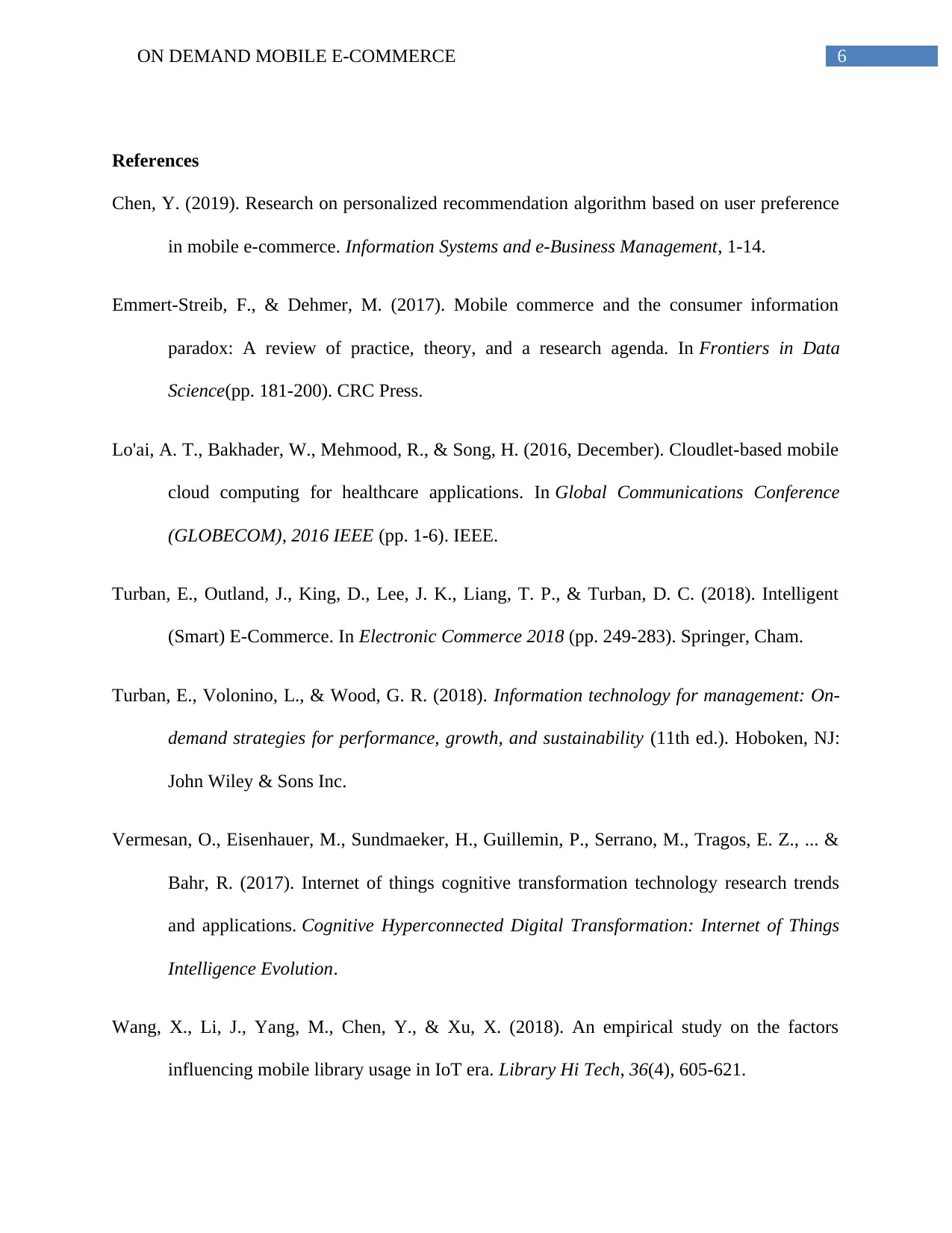
6ON DEMAND MOBILE E-COMMERCE
References
Chen, Y. (2019). Research on personalized recommendation algorithm based on user preference
in mobile e-commerce. Information Systems and e-Business Management, 1-14.
Emmert-Streib, F., & Dehmer, M. (2017). Mobile commerce and the consumer information
paradox: A review of practice, theory, and a research agenda. In Frontiers in Data
Science(pp. 181-200). CRC Press.
Lo'ai, A. T., Bakhader, W., Mehmood, R., & Song, H. (2016, December). Cloudlet-based mobile
cloud computing for healthcare applications. In Global Communications Conference
(GLOBECOM), 2016 IEEE (pp. 1-6). IEEE.
Turban, E., Outland, J., King, D., Lee, J. K., Liang, T. P., & Turban, D. C. (2018). Intelligent
(Smart) E-Commerce. In Electronic Commerce 2018 (pp. 249-283). Springer, Cham.
Turban, E., Volonino, L., & Wood, G. R. (2018). Information technology for management: On-
demand strategies for performance, growth, and sustainability (11th ed.). Hoboken, NJ:
John Wiley & Sons Inc.
Vermesan, O., Eisenhauer, M., Sundmaeker, H., Guillemin, P., Serrano, M., Tragos, E. Z., ... &
Bahr, R. (2017). Internet of things cognitive transformation technology research trends
and applications. Cognitive Hyperconnected Digital Transformation: Internet of Things
Intelligence Evolution.
Wang, X., Li, J., Yang, M., Chen, Y., & Xu, X. (2018). An empirical study on the factors
influencing mobile library usage in IoT era. Library Hi Tech, 36(4), 605-621.
References
Chen, Y. (2019). Research on personalized recommendation algorithm based on user preference
in mobile e-commerce. Information Systems and e-Business Management, 1-14.
Emmert-Streib, F., & Dehmer, M. (2017). Mobile commerce and the consumer information
paradox: A review of practice, theory, and a research agenda. In Frontiers in Data
Science(pp. 181-200). CRC Press.
Lo'ai, A. T., Bakhader, W., Mehmood, R., & Song, H. (2016, December). Cloudlet-based mobile
cloud computing for healthcare applications. In Global Communications Conference
(GLOBECOM), 2016 IEEE (pp. 1-6). IEEE.
Turban, E., Outland, J., King, D., Lee, J. K., Liang, T. P., & Turban, D. C. (2018). Intelligent
(Smart) E-Commerce. In Electronic Commerce 2018 (pp. 249-283). Springer, Cham.
Turban, E., Volonino, L., & Wood, G. R. (2018). Information technology for management: On-
demand strategies for performance, growth, and sustainability (11th ed.). Hoboken, NJ:
John Wiley & Sons Inc.
Vermesan, O., Eisenhauer, M., Sundmaeker, H., Guillemin, P., Serrano, M., Tragos, E. Z., ... &
Bahr, R. (2017). Internet of things cognitive transformation technology research trends
and applications. Cognitive Hyperconnected Digital Transformation: Internet of Things
Intelligence Evolution.
Wang, X., Li, J., Yang, M., Chen, Y., & Xu, X. (2018). An empirical study on the factors
influencing mobile library usage in IoT era. Library Hi Tech, 36(4), 605-621.
Paraphrase This Document
Need a fresh take? Get an instant paraphrase of this document with our AI Paraphraser

7ON DEMAND MOBILE E-COMMERCE

8ON DEMAND MOBILE E-COMMERCE
⊘ This is a preview!⊘
Do you want full access?
Subscribe today to unlock all pages.

Trusted by 1+ million students worldwide
1 out of 9
Related Documents
Your All-in-One AI-Powered Toolkit for Academic Success.
+13062052269
info@desklib.com
Available 24*7 on WhatsApp / Email
![[object Object]](/_next/static/media/star-bottom.7253800d.svg)
Unlock your academic potential
Copyright © 2020–2025 A2Z Services. All Rights Reserved. Developed and managed by ZUCOL.





